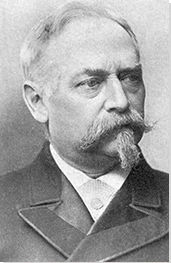Summary of Richard Morris Hunt
Hunt is widely credited with transforming American architectural design into a venerable artistic profession. Working with the monied classes of America's so-called "Gilded Age", he emerged as the most recognized architect in America on the back of a number of extravagant residential mansions. But Hunt, who was happy to adapt his style to suit the preferences of his patrons, proved to be a highly adaptable designer and was a pioneer across a range of less ostentatious styles including the picturesque - or "stick-style" - villa, the apartment house, the municipal building, and the national monument. Referred to by his peers as the "Dean of American Architecture", Hunt was also a key figure in the advancement in architectural education and was a co-founder of the American Institute of Architects.
Accomplishments
- Hunt's most ostentatious and resplendent structures were based on the lavish French Beaux-Arts and Renaissance designs and were renowned for the richness of materials, and the creativity of their design. His best known (and, for many modern critics, most tasteless) residential mansion, such as The Biltmore Estate (thought at the time to be the largest private residence in America) and The Breakers, were set in vast grounds decorated with classical sculptures and featuring sprawling terraces and arcades perfectly suited to outdoor dinner parties, balls and other high-society events.
- Throughout his later career Hunt worked on designs for several memorial monuments and public buildings, most notably the base for The Statute of Liberty and the Fifth Avenue entrance to The Metropolitan Museum of Art. To these (and others like it), Hunt brought a variety of classical columns and arches. The prestige of these commissions was such that they symbolized, in the words of Curator Morrison H. Heckscher, "the ultimate triumph of French classicism over the English High Victorian Gothic that had dominated American public buildings during the 1860s and 1870s".
- Hunt designed what was known as the "Stuyvesant Apartment" building. It was a five story multi-resident block and, based on the model of "French flats", the Stuyvesant was considered a first of its kind in America and gave rise to the style that became known as the "apartment house". The façade of the apartment house was (as the name suggests) designed to look like a row of houses, while the apartments themselves were affordable and especially popular with young couples who were just starting out on building a family.
- Bringing his European training to bear, Hunt was one of the pioneering figures in the development of the architectural profession in America. As a key figure in the newly formed American Institute of Architects (AIA), he helped set new precedents for architectural education that moved it beyond the apprentice system by establishing a set of stylistic, technical, intellectual and professional principles. The AIA put in place the foundations for the first academic architectural training programs that would spread throughout America.
- By way of contrast to his excessive Beaux-Arts designs, Hunt produced several "stick-style" domestic wooden residences featuring pointed roofs, gables and decorative wooden frames. Based on the model of the Swiss chalet, Hunt's cottage designs brought a distinctive look to Newport and enhanced its status as summer resort. Hunt had inadvertently initiated a style that became known amongst American's as the Colonial Revival style.
The Life of Richard Morris Hunt
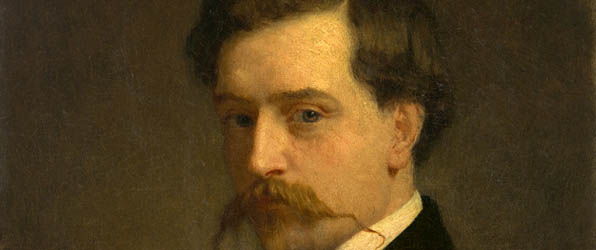
In order the reach highest professional standards in architecture, Hunt told his peers: we "must be most conscientious in our endeavors to faithfully serve the interests of our clients to the best of our ability", and to apply that value, "even should it at times be necessary to sacrifice some of our artistic preferences".
Important Art by Richard Morris Hunt
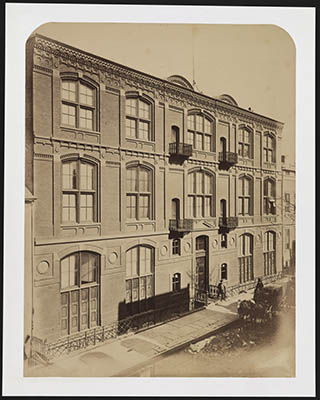
Studio Building, 51 West Tenth Street
One of Hunt's earliest jobs, the building effectively launched his career. He received the commission from James and John Johnston who wanted to create a space dedicated to artists and their work. Hunt biographer Paul R. Baker explains how "the dramatic fenestration, the huge recessed studio windows extending almost from floor to ceiling [....] The four small balconies, with elaborate black iron grillwork, the first-story brickwork panels, with decorative circles set in square frames, the brick piers topped with Greek crosses, and the boldly defined entrance surmounted by a triangular pediment and the word "Studios" chiseled directly above the door all made for an interesting play of surface elements ". The interior of the building was equally impressive as it consisted of twenty-five large studio spaces some with adjoining rooms that were to serve as bedrooms, and a large exhibition room for communal use. It was the first building of its kind in New York City.
Baker explains, "the Studio Building was an immediate success. The first tenants, including some of the best-known painters of the day, moved into the building early in 1858 [...] Many of the painters were members of the National Academy of Design, and for years works by tenants of the Studio Building dominated the exhibitions of the Academy ". Among the artist residences were Albert Bierstadt, Frederic Church, William M. Hart, Winslow Homer, and Emanuel Leutze. Hunt himself was so taken by the finished building he rented a studio on the third floor shortly after the building opened and remained there until 1870. Sadly, the building was demolished in the 1950s.
New York, New York
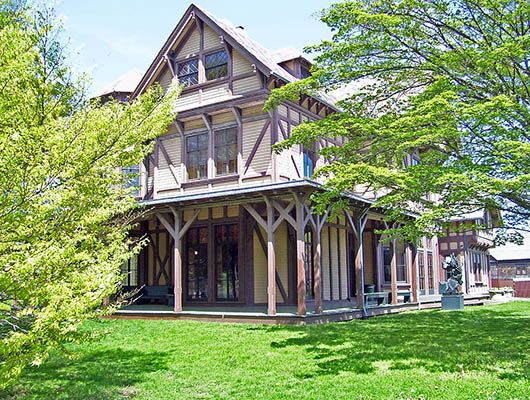
J.N.A. Griswold House
Griswold House is an elaborate domestic wooden residence featuring pointed roofs, gables and a decorative, partially exposed, wooden frame. As professor Sarah Bradford Landau explains, Hunt was "inspired by the contemporary revival in Germany and France of half-timber houses, the Swiss chalet, and other vernacular styles of wood architecture ". One can see that here in Hunt's use of the "stick style" which became popular in both America and Europe at the time and is evident in the overall verticality of the house's design features and visible frame elements.
His first commission for a project in Newport, Hunt was hired to build a summer residence for the wealthy merchant John Griswold. This house marked the start of a series of cottages designed by Hunt which energized and elevated the look of Newport and its reputation as a summer resort area. Landau cites the architect Alfred Janson Bloor who stated "in Newport Hunt was one of the first to invest comparatively inexpensive cottages and villas with some of the attributes of an indigenous and coherent art [....] Bloor rightly credits Hunt with having stimulated a new development in American domestic architecture, a development that would culminate in the vernacular expression known as the Colonial Revival ". The Griswold house marked the first of several elaborate residences he would design for clients in Newport, although in later years, he would move away from the cottage "stick style" and favor more ornate, decorative and sculptural structures.
Newport, Rhode Island
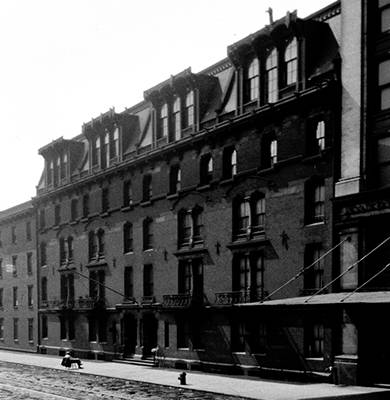
Stuyvesant Apartments
Hunt's elaborate multi-resident building, known as the Stuyvesant Apartments an impressive five stories. Aesthetically pleasing the buildings front façade, according to Landau, was deliberately designed, "as if to suggest the parlor floor of the New York row house, the second-story windows were longer than those of the other floors [...] Partition walls, visible on the roof, as well as the pattern of the fenestration of the floor immediately below the roofline contributed to the impression of a row of houses ".
Groundbreaking in its design, the Stuyvesant was one of the first apartment buildings built in America. In describing the legacy of this project, Landau states, "it was probably the first American building to be called an apartment house, and was certainly the first to be recognized as such; and it did stimulate the building of 'French flats' (the popular term in New York for the apartment house) in the 1870s ". The building was positively received by the public and according to Baker, even "before the Stuyvesant Apartments were finished, several prominent people had subscribed for flats there, many of them young couples with small families who considered the apartments particularly suited to their needs ". In this way, the apartment building owed its origins in no small part to Hunt's architectural vision.
New York, New York
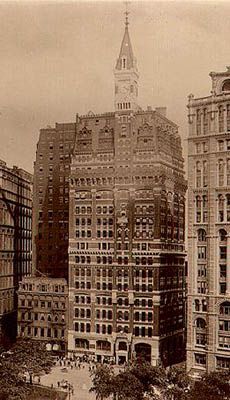
Tribune Building
At the time of construction, Hunt's New York Tribune Building was one of the tallest structures in the city, and at ten stories high, is considered one of the first skyscrapers. In praising the structure, Baker described how, standing on its "well-defined base of light-colored granite", Hunt had designed "walls faced with deep red Baltimore brick with geometrical designs in black, white, and red brick, and the windows, the cornices, and the tower trimmed with the same light-colored granite". He adds that "The tower rising over the main entrance was corbeled on piers from the upper part of the fourth-story level and was a sharply defined unit, narrower than the other three triply fenestrated bays ".
An important early commission, this building served as the headquarters for the New York Tribune newspaper, and is one of the many commercial projects Hunt was involved in during his career. While today he is remembered largely as a classical architect, the Tribune Building shows that he was open to the influences of modernism. According to Landau, indeed, "several [parts] of the Tribune Building's construction were decidedly avant-garde. These include the composition of its concrete-bedded foundation, the structure of its giant relieving arches (seen in the first and fourth stories), and its fireproof floor construction ".
New York, New York
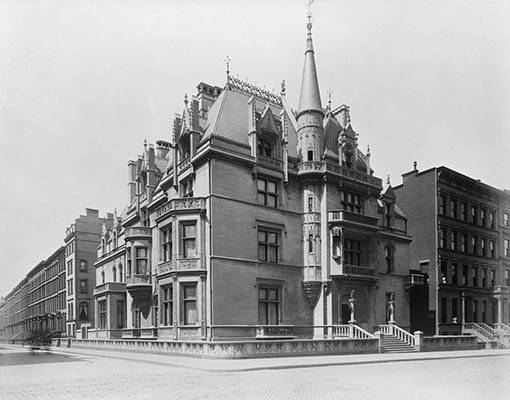
William K. Vanderbilt House
Hailed on its completion as, "the architectural masterpiece of Manhattan's Fifth Avenue", Hunt's Vanderbilt House gave rise to a new demand for French Renaissance "châteauesque" style residences across America. Built of gray limestone, the Vanderbilt House was elaborately decorated with exterior flourishes including copper trim work, rounded arches, pointed peaks above the top floor windows, a balcony over the doorway, and a tourelle topped with a pointed cylindrical roof. The interior was equally ornate with a banquet hall featuring a long fireplace with marble carved sculptures by artist Karl Theodore Bitter, and a long stained glass window depicting Kings Francis I and Henry VIII.
Vanderbilt was a patron of Hunt's and the architect had already completed other commissions for the family before he took this job to build a Manhattan townhouse for him and his wife, Ava. Hunt had a guiding philosophy for his work which was to place the wishes of his clients above his own ideals. He believed fervently that architects, "should be most conscientious in our endeavors to faithfully serve the interests of our clients to the best of our ability; to do so even should it at times be necessary to sacrifice some of our artistic preferences".
The Vanderbilt House was arguably the greatest of Hunt's residential commissions and it brought both him and his client great national attention. For Hunt specifically, it showed him as an architect with great panache and it led to several other residential commissions. According to Baker, "for several years this house was the most widely admired residence in New York City and, probably to a greater extent than any other American dwelling of the Gilded Age, set a goal for Americans of wealth and fashion to emulate. The mansion was opened to guests in March 1883, with a great housewarming costume ball, one of the most lavish parties of the time and an affair that established the preeminence of the Vanderbilts in New York society ".
New York, New York
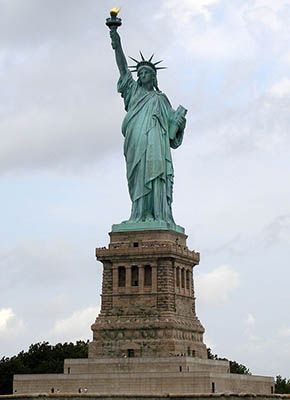
Statue of Liberty National Monument
A gift from the French government to the United States as a symbol of friendship, the Statue of Liberty (Liberty Enlightening the World to give it its original title) is a grand neoclassical sculpture of the Roman goddess standing with torch held high in her right hand, and a tablet inscribed with the date of America's independence in her left. In 1881, Hunt was selected by the American Committee of the Franco-American Union to serve as architect in chief on designing and building the pedestal on which Frédéric Auguste Bartholdi and Gustave Eiffel's iconic 151 feet tall copper and steel sculpture would stand (Liberty's internal architecture was designed by Viollet-le-Duc, the French medievalist). Once she was stood atop Hunt's granite pedestal, for which he used unfussy Greek Doric columns so as not to distract from the majesty of Liberty herself, the structure stood at just over 300 feet.
During his career Hunt worked on designs for several memorial monuments with the Statue of Liberty being his most prestigious commission. Construction on the pedestal's foundation was completed in May of 1884 and then, piece by piece additional elements of the pedestal were built up from the base. This project was not without its problems, however. While there was a campaign to raise funds to build the pedestal, by fall of 1884 the committee had run out of money. The news mogul, Joseph Pulitzer, stepped in and launched a publicity campaign through his paper the New York World and over the next several months the remaining $100,000 was raised allowing Hunt to resume work in May of 1885. Through his participation in this symbolic project, Hunt was able to create something that united the two countries that had combined to shape his artistic vision.
Liberty Island, New York
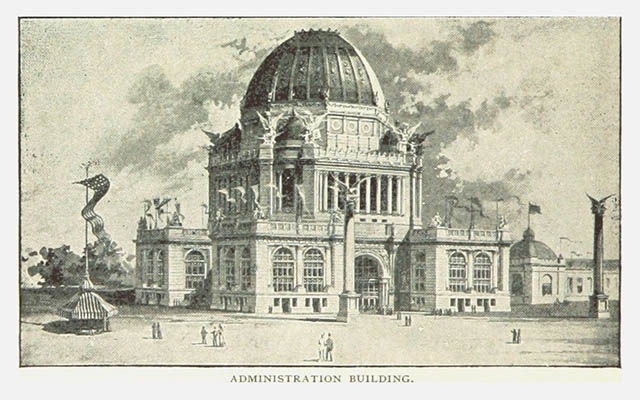
Administration Building
Hunt received a significant honor late in his career when he was selected to lead the New York architects delegation at the prestigious World's Columbian Exposition. According to curator Lewis I. Sharp, "because of his supreme position in the field of American architecture, he was invited to design the Administration Building that was to stand at the end of the Court of Honor [...] Hunt's building, grand in scale and with a great central dome flanked by four square four-story pavilions, was nonetheless a classically reserved building ".
Hunt collaborated with Karl Theodore Bitter to create the sculpture for his building; a fact which underlines the importance Hunt placed on art and architectural designs. The series of figures Bitter designed were, according to Baker, intended to show "the evolution of man from barbarism to civilization[and were beautifully integrated with Hunt's architectural vision]. The repose of the lower figures accentuated the solidity of the architectural design, while the animation of the uppermost groups provided a transition from the vertical emphasis of the lower part of the building to the curved lines above, reinforcing the spring of the dome ".
In spite of declining health, Hunt diverted all his energies into the Exposition project and considered it one of his greatest personal achievements. The public it seems were in general agreement with the building becoming a hugely popular attraction amongst exposition attendees. According to Sharp, "out of the fair came a renewed stimulus to the American Beaux-Arts neoclassical revival and the 'City Beautiful' movement that was to dominate American urban planning for the next quarter century ".
World's Columbian Exposition, Chicago Illinois
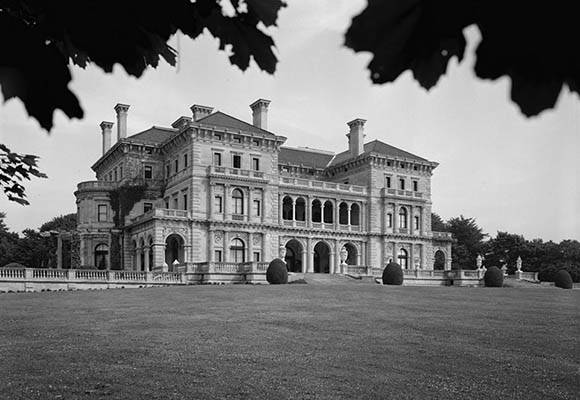
The Breakers
Hunt's grandest structure, The Breakers was a three-story mansion featuring more than seventy rooms which served as a summer home for Cornelius Vanderbilt. According to Baker, "here in Newport, Hunt constructed the American equivalent of a Genoese seaside palace of the Renaissance. The dwelling was a summer place, and the loggias, terraces, and arcades for outdoor activities were made an integral part of the plan and the design. Moreover, with the high ceilings [...] and the very large rooms, some flowing one into another, the mansion, despite its balanced formality of design, was given an open and airy character, appropriate to summer living and summer weather conditions ". Hunt sacrificed some of his own ideas for the mansion to satisfy the owner's wishes, and while he preferred to design in the French Renaissance style, here he designed drawing inspiration from the Italian architecture of that period which was at the behest of the Vanderbilts.
While Hunt was in high demand amongst the millionaire elites, his lavish designs did little to enhance his wider reputation. According to Baker, "The Breakers provided richly ornate and theatrical settings for the lavish dinner parties, the costume balls, and the other entertainments that became so characteristic of fashionable society during the summer season in the years around the turn of the century" and yet "to many social critics [...] the extravagant display was simply appalling ".
Newport, Rhode Island
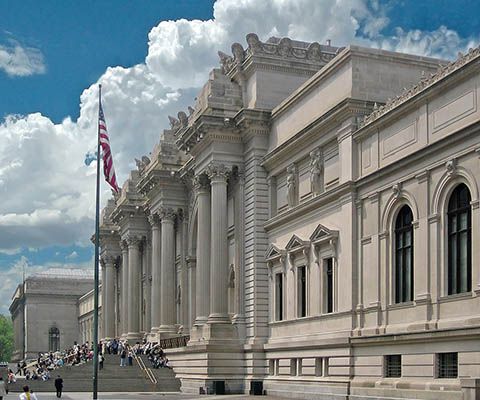
The Metropolitan Museum of Art
In 1895 the trustees of The Metropolitan Museum of Art agreed to an expansion on the east side (Fifth Avenue) of the building to allow for more space and to better accommodate their expanded collection. As one of its longtime benefactors - he had already served on its board and donated works to its collection - Hunt was given the commission for this extension. Baker states that "the interior of Hunt's Fifth Avenue wing is largely occupied by the grand entrance hall, some 166 feet in length, 48 feet in width, and two stories high" . Commenting on the exterior, meanwhile, he states that "The variety of architectural sculptural elements - the powerful columns, the jagged stone masses, the graceful arches, the portrait heads and the roof-edge masks, the convoluted caryatids, the rough-hewn base, the severe projecting triangular pediments over the lateral windows, the simple panels - gives the front an intrinsic interest ".
Sadly Hunt died having completed the designs but without seeing them realized. Upon his death there was disagreement amongst the trustees as to whether his son Richard Howland Hunt should take over as architect. As the terms of his will left the plans to Hunt's wife Catharine, however, she refused to release the designs to the museum unless her son could honor his father's memory. As Curator Morrison H. Heckscher states, "it was a building of superlatives: Hunt's last project and his most famous public building [...] It was, as the president of the Museum noted at the time of Hunt's death, his monument. Furthermore, the Museum building symbolized a number of things: the ultimate triumph of French classicism over the English High Victorian Gothic that had dominated American public buildings during the 1860s and 1870s, the acceptability of the placing of great museum buildings prominently in public parks, and the recognition, perhaps, that such large and complex buildings should only be designed by architects of the highest standing ".
New York, New York
Biography of Richard Morris Hunt
Childhood
Richard Morris Hunt was born into a family of wealth and privilege. His father, Jonathan Hunt, a successful lawyer, was elected to a seat in Congress just weeks after Richard was born. Sadly, when Hunt was only four years old, his father contracted cholera and died. Left with five young children to raise, Hunt's mother, Jane Maria, left Washington, D.C. and moved first to New Haven. The loss of his father notwithstanding, Hunt's childhood was a happy one and his mother nurtured the creative interests in all her children (indeed, his brothers, William and Leavitt, became professional painters and photographers respectively).
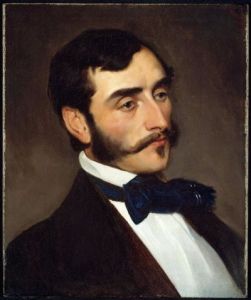
During her own childhood, Hunt's mother had shown a great passion for drawing and painting but her efforts were cruely put down by her father. Once a mother herself, she resolved to encourage the artistic impulses of her own children. Shortly after her husband's death, an Italian artist and political refugee called Gambedella had arrived in New Haven bringing with him letters of distinction. Jane Maria Hunt offered him lodgings in the large family home. Having failed to find pupils for start his own art classes, Hunt's mother hired Gambedella as the personal tutor for her and her children. The Hunt's worked with zeal and at the end of their first term together, the Hunt family put on an impromptu exhibition which aroused great local interest. (Other locals expressed an interest in joining Gambedella's class but Hunt's mother declared "You are too late!" as she retained the Italian's services only for her own family). Jane Maria sent her children to the best schools with Richard attending the Latin School in Boston (from where he graduated in 1843). However (also in 1843) Hunt's elder brother, William, fell seriously ill. William's physician recommended warmer climes to aid his rehabilitation and, not wanting to break up her family, Jane Maria Hunt moved her entire family to Italy via Southern France. The Hunts were so taken with Europe they would remain on the continent for the next twelve years.
Early Training
Shortly after arriving in Italy, Hunt and his younger brother were enrolled in a military school in Geneva (in neighboring Switzerland). At the time, the sixteen-year-old Hunt was planning on a military career but his plans changed having been awestruck by the great monuments and buildings of Europe and through an extracurricular course he had enrolled on with the architect Samuel Darier. Hunt wrote to his mother declaring that he wanted to study in Europe and then, "return to America where an architect of first quality would be much sought for ".
After finishing school in Geneva, Hunt joined his family in Paris and, in 1846, at the second attempt, was accepted into the École des Beaux-Arts, then the leading architectural school in the world. He was the first American to be enrolled in the architectural study program. In accordance with the school's policy, Hunt had to align himself with a professional atelier and was fortunate to benefit from the patronage of Hector Martin Lefuel. After six years at the École, Hunt's first professional job came in 1854 when Lefuel received a commission from Emperor Napoleon III to oversee extensions to the Louvre connecting it to the Tuileries Palace (Palais-Royal). Lefuel hired Hunt to be his Inspecteur des Travaux (Works Inspector); a prestigious position for a young American to receive so early in his career and, with Lefuel and Louis Visconti, designed the Pavillon de la Bibliothèque (Library Pavilion), situated opposite the Palais-Royal.
Once the Louvre project was completed, Hunt (who had by now also drawn inspiration on tours throughout Europe, Asia and Egypt) made the decision to return to America and set up his own architectural practice. It was not an easy decision. As Hunt biographer Baker explains, "the temptations for him to remain in France had been great. After a thorough training at the École des Beaux-Arts, he was recognized as a remarkably talented person. The opportunities for an interesting and successful career in France appeared excellent [...] But on the other hand, Richard was strongly drawn back to his native land. Here he recognized, there was great opportunities for an architect with skill, sound training, and good experience ".
Mature Period
A twenty-seven-year-old Hunt returned to New York City in September 1855 with the goal of bringing American building design into line with the best of Europe. He quickly began receiving commissions; the first of which was a townhouse for the artist Thomas Rossiter. This was soon followed by a commission for a building specifically designed to house artist studios and residences. Although it opened with only four students the Studio Building on West Tenth Street, brought Hunt his first taste of recognition in America. Hunt was so pleased with his design that he himself became one of the tenants and set up his own atelier in the building and filled it with an impressive art and book collection which he had amassed while living and training in Europe. Professor Sarah Bradford Landau explains, "Hunt's New York atelier, in existence from 1857 to 1860, is credited with transmitting to America the École rigorous system of training" and which was fully realized by his pupil William R. Ware ("who headed the first American school of architecture, founded at MIT in 1868, and went on to head the Columbia University School of Architecture"). Indeed, in addition to Ware, the studio also provided the early training ground for architectural luminaries Henry Van Brunt and Frank Furness, and the artist William Merritt Chase.
As Hunt's reputation grew, he received many important commissions and, with 12 other members, including the gothic architect Richard Upjohn, founded the American Institute of Architects (AIA) in 1857. The role of the AIA was to promote and regulate good practice in American architecture (Upjohn was elected the first AIA president and was succeeded by the Greek classicist Thomas Ustick Walter before Hunt became its third president). Hunt designed his first town house in 1857 for the artist Thomas P Rossiter who refused to pay Hunt a five percentage architect's fee. Hunt sued Rossiter with the court case setting a legal precedent for fixed charges for architectural services bringing the practice into line with other professions such as law and medicine.
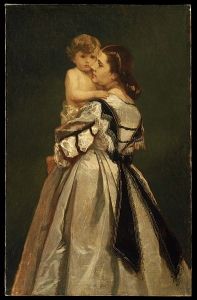
In 1860 Hunt also began receiving jobs in Newport, Rhode Island, where his brother, William, had by now made his name as an artist. It was in Newport in fact that he met his future wife, Catharine Clinton Howard, fourteen years his junior. The couple married in April 1861 and would raise five children. In addition to their apartment in New York, the Hunt's purchased a home in Newport known as Hill Top Cottage. Falling comfortably into family life, Hunt established a pattern that would continue for the rest of his career: securing important commissions in America interspersed with extended periods of rest and renewal via trips abroad with his family. Hunt also enjoyed a thriving social life and as Baker explains, "their Sunday dinners became features of New York artistic and literary life. Hunt maintained a well-stocked wine and liquor cellar and collected recipes for burgundy and champagne punch for their larger receptions [...] Catharine's temperament was serene and gentle, providing a complement to Richard's fiery, exuberant nature ".
In addition to domestic projects, including houses and apartment buildings, Hunt worked on several notable public projects including the Presbyterian Hospital (1872), the Tribune Building (the tallest commercial building in the city and one of the earliest with an elevator (1876)) and several buildings on the Yale University campus. However, with a grand courtyard and two wings, and a Neo-Grec facade emphasized through proud columns and rounded arches, the two-stories Lennox Library is widely considered one of Hunt's most important designs of the 1870s and a masterpiece in the decorative French Beaux-Arts style. Baker described how the wealthy philanthropist James Lenox met Hunt in 1867 and "soon became Hunt's patron, employing him for some major projects ". The most important was a public library that would house Lenox's extensive book and art collections. In accepting this commission, Hunt grew his reputation by designing what would be one of New York's earliest public libraries and exhibition spaces. (The library was sadly demolished by another wealthy city figure, Henry Frick, who purchased the land in 1912 and is today the site for The Frick Collection art museum. However, following Hunt's death a memorial to him was erected in Central Park facing the site of the original Lenox Library.)
Unfortunately the intensity of his work during this period led to a weakening of Hunt's health and in 1868 he developed a serious case of gout, a painful condition he would have to battle for the rest of his life. He also suffered three other significant setbacks. The first two were personal losses with the deaths of brothers John and William due to suicide (or rather in William's case, suspected suicide). The third, which was perhaps his greatest professional disappointment of his career, came when he submitted his initial designs for the proposed gateway entrances to the newly developed Central Park in New York City. His plans were accepted by the committee overseeing the project however once they were presented to a larger audience they were met with widespread disapproval. According to professor Francis R. Kowsky, "all of Hunt's designs derived from the grand tradition of French civic planning " and proved just too far removed from the natural focus of Frederick Law Olmsted's original park design. It was, as Kowsky explains, a sentiment articulated at the time by the art critic Clarence Cook who wrote "Hunt's designs were as 'un-American as it would be possible to make them' and unsympathetic to the rural character of the park ".
While the sculptural elements of Hunt's Gateway designs did not garner public approval, he continued to advocate in favor of the connection between sculpture and architecture and often collaborated with sculptors on monument projects. Indeed, throughout his later career he was part of several projects that involved collaborations with two key artists, John Quincy Adams Ward and Karl Theodore Bitter. These involved commissions for monumental memorial sculptures including the Washington Statue in New York (1883), and the Yorktown Monument in Virginia (1884). But Hunt's most important monument commission would be the design for the base and pedestal for the Statue of Liberty (1886).
Late Period
Despite complaints from some quarters that Hunt's designs were "too European" (and, by extension, "un-American"), the last decades of Hunt's career were very busy. As Baker explains, "as he advanced in age and as his reputation grew, more and more work came to him. He often complained that he had more work than he could conveniently take care of ". His eldest son, Richard, joined the family firm in 1887 having also studied at the École des Beaux-Arts. (A second son, Joseph Howland Hunt, would join the firm in 1901, after his father's death.)
Commissioned by George W. Vanderbilt, Biltmore House was one of Hunt's most grandiose designs and stands as a fine example of his Châteauesque style. It proved a massive undertaking for Hunt who spent a good six years on the project and worked once more with artist Karl Theodore Bitter who designed and created the sculptural elements for both the exterior and interior of the house (including a marble frieze and relief panels as well as a carved fireplace). The commission also saw Hunt collaborate with the renowned landscape architect, Frederick Law Olmsted, who designed Biltmore's spectacular gardens. Indeed, the grounds surrounding the house and garden eventually grew to some 125,000 acres and was the first full-scale experiment in scientific forest management undertaken in the United States.
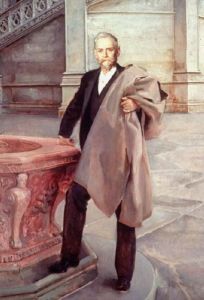
While Hunt received several late career commissions for public buildings, including the Administration Building for the World's Columbian Exposition in Chicago (1893), his work at this time was largely focused on building elaborate houses for some of the East Coast's wealthiest citizens. According to Baker, "these great residences were among his most noteworthy work and contributed importantly to his subsequent historical reputation. By this time, Hunt was well known as the most fashionable architect in the country, and no doubt some clients sought his services to reinforce their claims for social position and acceptance ". Part of Hunt's success can be attributed to his flexibility and his willingness to adapt his designs to the wishes of his clients. As he said, "it's your clients' money you're spending. Your business is to get the best results you can, following their wishes. If they want you to build a house upside down, standing on its chimney, it is up to you to do it and still get the best possible result".
On March 22, 1893, Hunt established The Municipal Art Society (MAS) with the founding mission to beautify New York through public art. The organization (which still runs today) soon expanded its mission to include the city's architectural landscape and other public spaces. But the weight of Hunt's workload was taking its toll on his health and in July 1895 he was stricken with an intense attack of gout. While hoping to recover in his Newport home, his health quickly deteriorated and he died on the last day of the month. His final commission, one for which he is still remembered today, was the designs for the Fifth Avenue entrance for The Metropolitan Museum of Art. His two sons would oversee the completion of the project which was completed in 1902.
The Legacy of Richard Morris Hunt
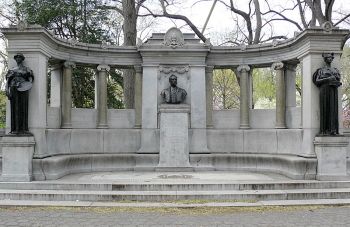
Hunt had a profound impact on the development of architecture in America. According to Baker, "in the second half of the nineteenth century, architecture became a respected profession in the United States, and Hunt more than anyone else was instrumental in shaping its dimensions and standards. Moreover, he did significant work in establishing professional education in architecture [and for] many years, he was the best-known spokesman of his profession in the United States ". While he may be best be remembered today for the excessive New York and Rhode Island residences, the rich variety of his commissions are testament to his flexibility and reach of his architectural vision. As Baker adds, "in his commissions for clients of great wealth, he was able to shape and to fulfill dreams and ideals in a way that few other Americans ever have. And yet his output was immensely varied, and he designed buildings for many private, commercial, and public purposes. His designs for several monuments and memorials helped forward the renewed unifying nationalism which followed the Civil War and Reconstruction ".
Hunt's Beaux-Arts architectural style was quickly overtaken by the advent of modernism. This, coupled with the fact that many of his buildings have been demolished over time, has meant that he is not perhaps as widely appreciated today as some of his contemporaries. Nevertheless, he left an indelible mark on American architectural history, especially when one takes into account the role he played in architectural education which had until his intervention worked on the apprentice system. Indeed, Hunt left behind a library of design documents and educational sources that numbered in the thousands. The American Institute of Architects and the American Architectural Foundation became custodians of his educational legacy, expanding his original collection to amass a body of materials - known today as the "AIA/AAF Collection" - that has been housed at the Library of Congress since 2010.
Influences and Connections

- Samuel Darier
- Hector Martin Lefuel
- Karl Theodore Bitter
- John Quincy Adams Ward
- Thomas Rossiter
- James Lenox
- George K. Vanderbilt
- Frederick Law Olmsted
-
![Beaux Arts Architecture]() Beaux Arts Architecture
Beaux Arts Architecture -
![Gothic Art and Architecture]() Gothic Art and Architecture
Gothic Art and Architecture -
![Romanesque Art]() Romanesque Art
Romanesque Art - French Renaissance
- Stick Style
- Henry Van Brunt
- Frank Furness
- William R. Ware
- Charles Gambrill
- Henry Louis Sullivan
- Mariana Griswold Van Rensselaer
- Charles Follen McKim
- Richard Upjohn
-
![Beaux Arts Architecture]() Beaux Arts Architecture
Beaux Arts Architecture ![Gothic Revival]() Gothic Revival
Gothic Revival- Châteauesque style
- French Renaissance
- Stick Style
 Ask The Art Story AI
Ask The Art Story AI